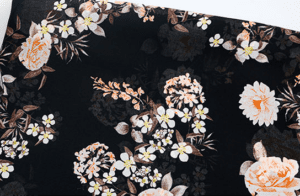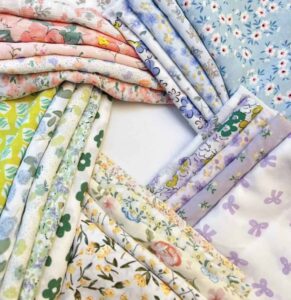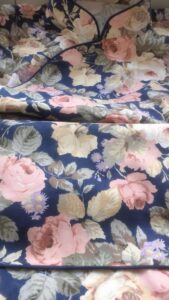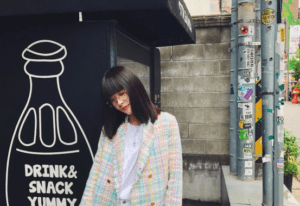Traditional printing and characteristics of paint
Overview of traditional printing of paints
The traditional printing methods used in the printing industry are reactive dyestuff, disperse dyestuff, acid dyestuff and direct printing with paint; among them, reactive dyestuff, disperse dyestuff and acid dyestuff printing are commonly used by the majority of printing and dyeing manufacturers because of the bright colours of the printed patterns, the fullness of the colours, the soft feel of the fabrics and the clear outline of the patterns; however, the environmental pollution problems brought about by this traditional printing method will be phased out. However, the environmental pollution problems caused by this traditional printing method will be gradually eliminated in this age when people are paying more and more attention to environmental protection and living environment; especially in foreign trade, it is difficult to achieve the certification of environmental protection and fabric safety. In addition, many foreign trade orders have added special requirements such as chlorine bleaching resistance, oxygen bleaching resistance, dry cleaning resistance, etc. Therefore, we must use the latest technical means to adapt to the market requirements, otherwise we will form a very passive situation and hinder the development of the industry. In this case, people naturally think of no pollution or less pollution printing method a paint printing.
Characteristics of paint printing
1. The process is short, it does not require pre-treatment and post-treatment, after printing and baking at high temperature, so that the coloured groups of paint are bonded to the fabric fibres, that is, the printing process is completed.
2. No effluent discharge, green and environmentally friendly.
3. High colour fastness; the coating inks are suitable for all kinds of fibres, including single-component and multi-component fabrics. The coating ink has excellent performance, bright colours, good light fastness and weather fastness.
4. Fastness to rubbing, especially wet rubbing, is poorer than with dye inks.
5.Traditional paint printing, due to the coverage and opaqueness between the colours, the combination with the fabric fibres is through the physical process of bonding with the chain agent, so the paint is not bright enough compared to other dyestuff printing, due to the opaqueness of the paint and the coverage of the base colour mixture, etc.; as the paint particles are adhered to the surface of the fabric, the feel is relatively poor.
In short, the advantages of paint is obvious, but how to overcome the existence of deficiencies, it seems necessary, in the traditional way of printing, people after continuous research, in terms of feel and colour vibrancy, although some improvement, but not satisfactory; many industry peers in the paint inkjet printing has done a lot of exploration, Hangzhou open source after years of dedicated research, in this field has made substantial progress and After years of research, Hangzhou Open Source has achieved substantial progress and good practical results in this field.
Principle and characteristics of digital printing machine
Principle of digital printing machine
Digital printing technology first appeared in the mid 1990s, the emergence and continuous improvement of this technology has changed the textile printing and dyeing industry traditional printing methods, its advanced production principles and means, to bring an unprecedented opportunity for development of printing and dyeing.
The principle of digital printing is that the pattern is transferred to the computer in digital form through a scanner, which is then edited and processed by a computer printing colour separation system (e.g. Chameleon printing colour separation software), and then a computer-controlled micro-piezo inkjet nozzle that jets a special dye (collectively known as ink) directly onto the textile, where the colours are mixed and restored to the original scanned pattern.
coating print active print
Digital printing features
It is characterised by its speed and short processing cycle; for a long time, due to the limitations of the traditional process, the production of printed products had to reach a certain scale and quantity before the enterprise could be effective. With the development of the economy, market demand is becoming more and more diversified and personalised. The emergence of digital printing technology has solved this long-standing problem for companies. In the past, it took several days or even dozens of days to deliver a product from design to delivery, but now the customer has chosen the pattern and fabric, 1 to 2 hours can be completed, to better meet the personalised needs of consumers to wear or decorate.
At the same time, digital printing can produce 16.7 million colours in four colours plus spot colours. Digital printing is not restricted by the printing process, so it allows textile designers to give full play to their creativity and to showcase their creative talents, turning their ideal work into a realistic finished product. For consumers, they can personalise their designs from home furnishings to clothing and travel goods.
As digital printing is a direct spraying of the dye solution on the fabric as required in a special box, there is no waste and no waste water pollution, eliminating the need for the dye solution to be discharged by the printing machine in the blending room and achieving a pollution-free printing process. It also eliminates the need for film. It also eliminates the consumption of materials such as film, screen and silver cylinders. This not only reduces the burden on the company, but also fulfils the requirements of environmental protection.
The development of digital printing technology, from the initial 4-colour (C, M, Y, K) 4 printhead printing, to today’s 8-colour (C, M, Y, K, LC, LM, LY, LK) 16 printhead printing (dual channel), or even more printhead combinations, and now the development of the basic colour and spot colour mixed printing combination, all these development process, are in order to have a richer fabric All these developments have been carried out in order to achieve a richer colour representation on the fabric; as the technology continues to mature and the process continues to be explored, digital printing will become more and more sophisticated.
Rainbow inkjet printers
The Rainbow 1800 series inkjet printers are equipped with the most advanced printheads available, making digital printing faster and more colourful, and with a variety of auxiliary devices that can be adapted to a wide range of textiles, such as cotton, linen, chemical fibres, silk and their garment cuttings and T-shirts. More importantly, the Rainbow inkjet printing machine is optimised for the most widely used type of paint printing, with the main parts of the printhead and ink being optimised to suit the requirements of paint inkjet printing, making it truly industrialised.
Rainbow inkjet printers use the most advanced international industrial grade stainless steel piezo printheads. The piezo printheads are capable of printing at high frequencies, have small ink dots and can accommodate high viscosity inks. Rainbow inkjet printers use printheads that can accommodate inks from 8-20 CPS, resulting in more saturated and vibrant colours on the printed fabric. The printhead height can be manually synchronised up and down from 0-25mm, making it less prone to clogging even when used for paint printing, more versatile, self-locking, more accurate and less costly to operate.
The Rainbow range of inkjet printers uses the same conveyor belt system as traditional printers, maintaining the compatibility of traditional printing with most fabrics such as stretch, knitted and woven fabrics. The carefully designed automatic feed and take-up unit with tension control provides innovative feed and take-up functions. The system uses an automatic tension control system, which eliminates the problem of excessive variation when adjusting manually. The tension is matched to the fabric by adjusting the weight of the tension spokes and by adding dividing spokes to level the fabric surface. The fabric is fed evenly onto the guide belt by means of the feed frame, and the spokes are used to press the fabric onto the belt by means of the pressure of the spokes.
The rainbow inkjet printing machine is also equipped with an automatic nozzle and tape cleaning function, which allows the remaining dye on the tape to be washed away without contaminating the blank, ensuring that the surface of the tape is clean and sticky. It is also equipped with a tape squeegee to ensure that the tape glue is evenly applied to the surface of the tape. The thin plate type electric heating drying method is safe, reliable, dust-free, noiseless and has a good drying effect to ensure continuous production of the fabric.
The ink supply system ensures that the head is not blocked by air bubbles during the printing process and meets the requirements of continuous fabric production. Ink supply on demand, reducing ink waste and production costs.
Nano coating ink
Nanocoat inks
Digital printing inks can be divided into dye inks and coating inks according to the pigments used. Theoretically all textile dyeing and printing dyes can be used to formulate inkjet printing inks, currently the main dyestuffs used are reactive dyestuff ink, acid dyestuff ink and disperse dyestuff ink. Due to the cumbersome process of dye inks described earlier, which have to go through pre-treatment and post-treatment, and the pollution of the environment by the effluent discharged, it is necessary to develop coating inks.
Coating ink properties for rainbow inkjet digital printing
Adaptability to the printhead; as the nano-coat ink is sprayed onto the fabric via a piezoelectric printhead, the size of the paint particles, the settling of the ink, the permeability of the ink once sprayed onto the fabric and the compatibility of the mixing between the basic colours must all be adapted to the requirements of the printhead.
(1)heating adaptability to the environment; because the coating ink has a hot melt adhesive, is used to heat, coloured groups bonded to the fibres of the fabric, and the printhead in the vicinity of the nozzle and around the coating ink, once the heating heat source, it is easy to condense and solidify, resulting in the blockage of the printhead, so the coating ink sensitive to temperature range, digital printing machine heating area and the design of the printhead position must meet the The design of the heating area and the position of the printhead must meet the requirements of a non-clogging printhead during the heating process.
(2)versatile for different fibres. Paint inks are suitable for a wide range of fibres; dye inks require different inks depending on the fibre.
(3)Simplicity of process. The application of coating inks for inkjet printing on fabrics does not require complex pre-treatment and post-treatment processes, the fabric is directly inkjet printed and then simply baked.
(4)Emissions are non-polluting. It contributes to the protection of the environment. Inkjet printing does not produce floating colours on the fibres after fixing the paint, so there is no need for washing to remove floating colours as with dye inks.
(5)good colour fastness properties. Paint inks are sprayed onto the fabric in tiny particles and are therefore not easily broken down by light, even if the outer molecules of the particles are broken down by light, the inner layers retain their colour. Unlike dye inks, which are sprayed onto fibres, they are in a molecular state on the fibres, and most of them are in a molecular state or in loose aggregates in the fibres, so they are susceptible to photolysis.
Rainbow digital inkjet printers using nano-coatings inks and dye inks tested and compared
Rainbow inkjet digital printing machine printing process parameters setting
4.1.1 Selection of ink volume
Piezoelectric nozzle, the frequency of its hitting point is very high, can be set according to the needs of the printing speed; as different fabrics (fabric thickness, material and other factors) will be a great difference in the amount of ink absorption, so how to choose the correct amount of ink in the print control software, is the key to printing a good pattern, Hangzhou Open Source Computer Technology Co. Ltd. developed the Rainbow digital inkjet printing machine print control software, can be very convenient to deal with this problem; according to the test printing ink penetration, according to 0%-500% free adjustment, until the best state. Of course, in the case of dye ink, the adjustment process should take into account that the ink will be removed after steaming and washing.
The usual experience values are as follows:
| Materials | Print accuracy | Ink quantity selection | pass | Remarks |
| Rough cotton | 900X600 | 320-330% | 6pass | Dye ink plus 10% |
| Medium cotton fabric | 600X600 | 330-350% | 6pass | Dye ink plus 10% |
| Fine cotton cloth | 600X300 | 330-350% | 3pass | Dye ink plus 10% |
| Double knitted ruminants | 300X600 | 320-350% | 6pass | Dye ink plus 10% |
| Plain crinkled satin | 300X600 | 300-310% | 6pass | Dye ink plus 10% |
| Power Spinning | 300X600 | 290-300% | 6pass | Dye ink plus 10% |
| Silk-cotton silk | 300X600 | 320-330% | 6pass | Dye ink plus 10% |
| Chokisa | 300X300 | 280-300% | 3 pass | Dye ink plus 10% |
The fusion process of ink and fabric in digital printing is completed in several stages, of which, the coating ink is only a physical process, directly after baking; while the dye ink has both physical and chemical processes; after the ink is printed on the fabric, for the dye ink fabric, as the fabric has been coated with sizing (sizing and drying), the ink will dissolve into the sizing and fabric, followed immediately by a drying device The ink is then dried at a temperature of around 100°C, which is the first time the colour is fixed; this is followed by vapourisation, the effect of which is that the coloured groups of the dye are linked to the fibres of the fabric by a chemical reaction in a hot and humid environment, which, due to the mixture of reflected light, reverts to the colour of the pattern.
4.1.2 Production of ICC for rainbow inkjet digital printers and choice of colour space conversion type
In fact, the deviation between the basic colour of different manufacturers of ink, different fabrics on the differences in ink absorption, ink mixing percentage and other factors, all affect the degree of colour reproduction of the pattern, so, to the printing process of colour calibration, which is commonly referred to as ICC, colour calibration on the production of preset files, only through the establishment of the relationship between colour conversion, in order to print a good colour reproduction of the pattern. The printing of textile patterns and advertising printing (using oil-based inks) has many different aspects, as mentioned earlier, UV ink printing, the ink mixing is a physical process, two water-based dye ink printing ink mixing process, both physical and chemical processes, so the production of ICC and pattern selection has the following experience can be referred to, they are: like figure perception, colour saturation, relative chromaticity, absolute chromaticity four. absolute chromaticity four.
a ) like figure perception
This is the most common type of conversion. This method changes all the colours in the source device’s colour space while keeping all the colour interrelationships intact, but leaving all the colours unchanged in terms of overall perception.
This is because our eyes are more sensitive to the interrelationships between colours and less sensitive to the absolute values of colours. If an image clearly contains colours outside the colour gamut, it is a good choice to use perceptual reproduction intentions. Ideal for printing composite clouds, photographs of people, landscapes, etc.
b ) Colour saturation
This method tries to maintain the vibrancy of the colours without much concern for colour accuracy. It reflects the most saturated colours in the colour space of the source device to the most saturated colours in the target device. This method is suitable for the reproduction of various charts and other commercial graphics, or for the production of maps with height or depth marked in colour, as well as for cartoons, caricatures and patterns.
c ) Relative chromaticity
Relative chromaticity is about accurately reproducing all the colours in the gamut, cropping out the colours outside the gamut and converting the cropped colours to their closest reproducible colour. Relative chromaticity reproduction intentions are a better choice than perceptual reproduction intentions for image reproduction, as they retain more of the original colours. Suitable for conversions between ICCs where the colour gamut is not too different, e.g. for fine patterns.
d ) absolute chromaticity
Absolute chromaticity does not map the white dots in the source device colour space to the white dots in the target device colour space. If the white in the source colour space is bluish and the white paper in the target colour space is slightly yellowish, when using the Absolute Colour Reproduction Intent, some cyan ink is added to the white areas of the output to simulate the original white. The Absolute Chroma Reproduction Intent is designed primarily for proofing purposes to simulate the reproduction of the final output device on a separate proofing device. Use with caution if the pattern has a particular emphasis on line fineness, but the new reproduction of colour has an impact, especially on white backgrounds.
All conversions between icc’s must follow these four conversion methods, there is no alternative. At the same time, when converting the icc files of an image, it is advisable to look at the changes brought about by the different conversion methods separately and choose the one that best suits the existing image.
Comparison of nano-coating ink and dye ink tests
4. 2.1 Selection of post-treatment process parameters
Active ink inks
Acid ink inks
Disperse dye inks
Paint inks
4. 2.2 Comparison of the colour vibrancy and feel of paint inks and dye inks
According to the actual use, the hand feel of inkjet printed fabrics is much improved compared to traditional paint printing, and good results have been achieved in practice on both cotton and silk.
Conclusion
According to the above physical comparison can be concluded, for the characteristics of paint printing, the application of rainbow inkjet printing machine, in RIP, control software, digital paint inkjet process, after repeated experiments and research, the production of the feel than traditional paint printing, close to the dye digital ink printing fabric; colour vibrancy is also close to the dye ink printing fabric effect, and with rainbow digital printing machine and nano paint ink The fabric printed with rainbow digital printing machine and nano coating ink has a colour fastness of more than 4 levels; it is a better new printing method for environmental protection, low carbon, energy saving and emission reduction, and has good market prospects and economic benefits.
























